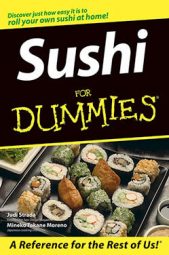Many of the bottled ingredients used when making sushi are probably familiar to you. These bottled sushi ingredients keep, unopened and in a cool dark pantry, for many months. Refrigerate opened bottles of sushi ingredients, such as soy sauce or rice vinegar, so that they taste good and last longer:
Thick chili sauce: Even though chili sauce didn’t start out as a Japanese ingredient, sushi bars would have to close their doors if they ran out of it!
Mirin (sweet cooking sake): A slightly syrupy, sweet cooking sake (about 8 percent alcohol).
Plum wine: True Japanese plum wine is made with unripened plums, rock sugar, and a strong distilled spirit, making it more of a sweet, fruity liquor than a wine.
Ponzu sauce: Authentic ponzu sauce derives its unusual fragrance and zip from yuzu, a lemon-colored, tangerine-shaped citrus grown for its zest, not pulp.
Rice vinegar: Mild but full of flavor. In a pinch, apple cider vinegar is a good substitute for rice vinegar.
Sake (Japanese rice wine): You needn’t invest in expensive sake for cooking purposes, but do buy one that’s drinkable.
Sansho (Japanese pepper): The dried and ground pods of the prickly ash tree that create a fragrant, finely ground pale spice that’s more minty-citrusy or tangy than spicy hot.
Soy sauce: Soy sauce was introduced to the Japanese by the Chinese centuries ago. The Japanese took this fermented soy bean sauce and tweaked its taste to suite their palates.
Shichimi togarashi (seven-spice chili seasoning): Traditionally contains fresh chili flakes, black and white sesame seeds, poppy seeds, sansho, ao-nori, and Mandarin orange peel.
Dark sesame seed oil: The roasted, nutty fragrance of dark sesame seed oil is enough to make anyone hungry!
Spicy sesame seed oil (rayu): Rayu is basically dark sesame seed oil, heated up with chili.

